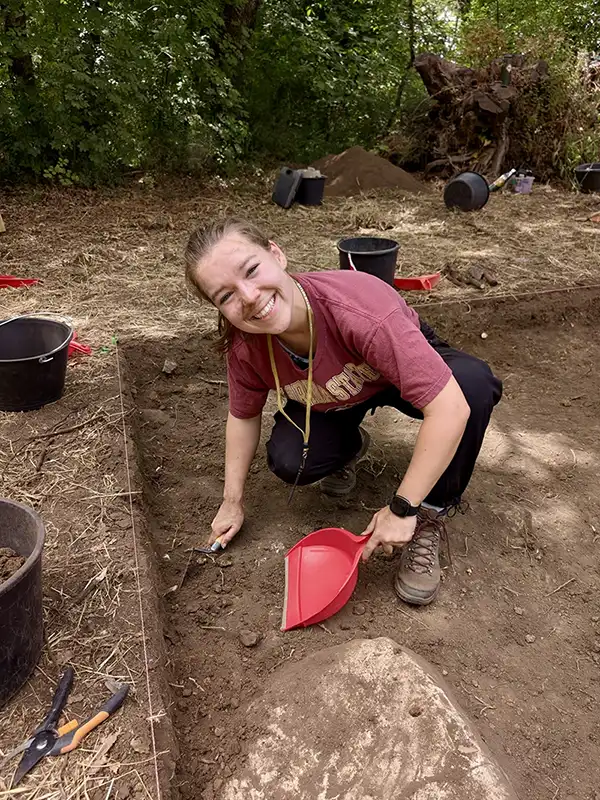UT Scholar Part of Rare Etruscan Tomb Discovery

UT doctoral student Anna Catherine Gibbs’ archaeology research took her to Italy and the opening of an undisturbed tomb from the seventh century BCE.
Anna Catherine Gibbs returned to Italy in the summer of 2025 for her seventh season of fieldwork on the San Giuliano Archaeological Research Project (SGARP), working with the team that lowered the blocking stone from a tomb.
“It was beyond thrilling,” said Gibbs, who is pursuing a PhD in Mediterranean archaeology from the University of Tennessee, Knoxville. “Despite being disturbed by flooding, the tomb was full of intact ceramic vessels, mortuary stone beds, and beautiful bronze and iron artifacts. It is so unbelievably rare for an archaeologist to ever see a discovery of this kind, as very few archaeological sites are truly preserved and undisturbed by human interaction.”
The region has few examples of complete Etruscan burials. “None from this period have been excavated using modern archaeological techniques—making this a nearly unique example of what burials were like during the late seventh to early sixth century BCE in our area, and providing an extremely rare look into Etruscan life and death,” she said.
The tumulus contained four individuals and 74 intact ceramic vessels, as well as bronze fibulae, iron spear points, silver hair coils, and glass beads. “This discovery provides exceptionally valuable, but rarely accessible, data about the original condition of Etruscan tombs before looting,” she said.
Unique Opportunities
Gibbs planned to become an elementary school teacher until an undergraduate study abroad trip to work with SGARP. Now she hopes to combine her love of teaching, research, and fieldwork as a professor. Over three semesters as a graduate student at UT, teaching Introduction to World Archaeology strengthened her knowledge of collegiate pedagogy as well as archaeological methods and regions.
She chose UT for her doctoral studies because of its Mediterranean archaeology program through the departments of anthropology and classics, and its professors. Her advisors are Professor Alex Bentley in the Department of Anthropology and Professor Stephen Collins-Elliott in the Department of Classics. “They have both been extremely impactful in motivating me to branch out, exposing me to new methods and techniques, and guiding my research questions,” she said.
“UT’s dual program is a unique and valuable opportunity for me to expand my expertise in both disciplines and to marry them into the kind of interdisciplinary archaeological practice of which I hope to see more,” Gibbs said.

SGARP is an interdisciplinary investigation of Etruscan and medieval histories in Lazio, Italy, and Gibbs’ research focuses on survey and landscape analysis. A Haines-Morris Travel Scholarship from UT’s Department of Classics mitigated her travel expenses for the fieldwork May 22 to July 11, 2025.
“I performed a widespread data check of San Giuliano’s Etruscan necropolis, which is comprised of over 616 rock-cut tombs,” she said. “While challenging to effectively model, these tombs are well represented through SGARP’s intensive survey, and my aim is to identify patterns of status, wealth, and labor mobilization in Etruria.”
SGARP’s work since 2016 has included both excavation and intensive survey. Excavations have exposed a medieval fortification and cemetery and several Etruscan rock-cut chamber tombs. In the survey, pairs of researchers have walked transects to document, photograph, and mark GPS coordinates for every visible tomb.
“For most of my involvement on SGARP I have been the total station director, taking XYZ points for mapping and working predominantly on the medieval excavation, but I have recently pivoted for my dissertation to a landscape analysis and Etruscan research focus,” Gibbs said.
“This summer I worked to identify areas of our survey data that were either missing, incomplete or faulty, and completed specific resurveys and spot-checks to update and solidify our current tomb count,” she said. “I aimed to identify and mitigate as many issues as possible so that I can do big-data analyses going forward.”
“Overall, our tomb survey data is very high quality, but with over 600 tombs, and several years of data collection from different teams—with the added challenges of erosion and typos—it can be helpful to go over things with a fine-toothed comb,” she explained. “I also collected some new data on tombs’ attributes, size, and volume for my future studies of tomb elaboration, construction, and status.”
Although there are visible patterns in the necropolis, she said, the tombs are very diverse. “Organizing such a large dataset into statistical groupings will shed light on the chronological phases, social statuses, and patronage systems of the Etruscan population at San Giuliano,” Gibbs said.
Toward the end of her tomb surveys in 2025 she assisted full time in the Caiolo Plateau excavation, where a trench was originally opened in 2022. Working across from a tumulus excavated in 2024, the team discovered another narrowing entryway or passage leading to a tomb.
“The real surprise came as we continued to dig and found the tomb’s blocking stone in place,” Gibbs said. When a small opening allowed the insertion of a borescope, it revealed the tomb was untouched. “The excitement was overwhelming,” she said. “After finishing the season in a whirlwind of preservation and data collection to make sure every single detail was documented, we are excited to begin the research and analysis in earnest.”
Gibbs said, “The complexity and beauty of the ancient Mediterranean is absolutely fascinating to me and poses a wealth of possible research avenues for my current and future work.”
By Amy Beth Miller